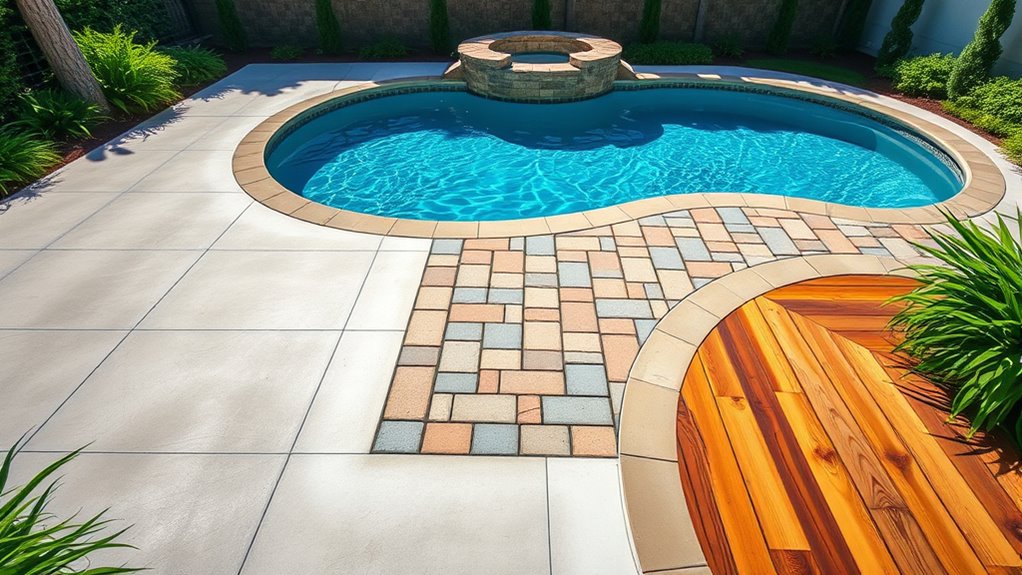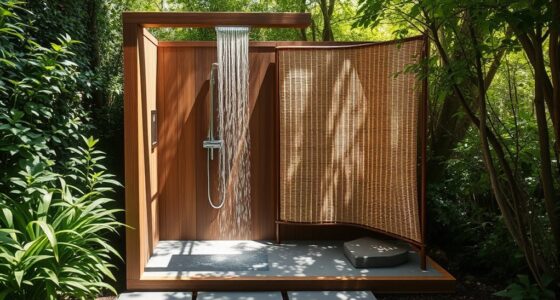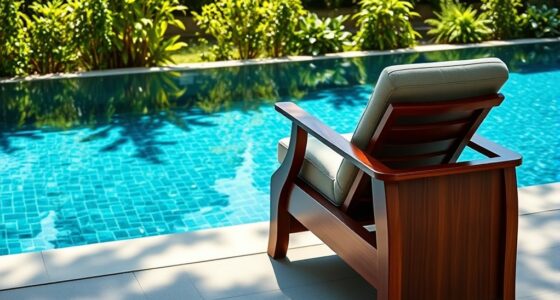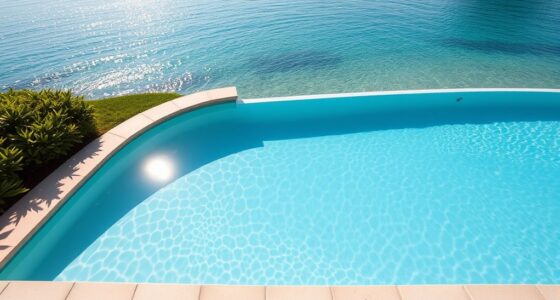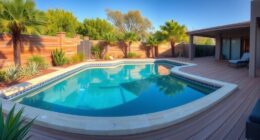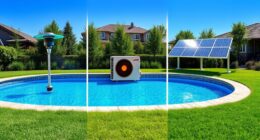When choosing poolside decking, consider durability, safety, and aesthetics. Concrete offers a sleek, modern look and is affordable but needs sealing to prevent cracks. Pavers are durable, easy to repair, and come in various styles, though they tend to be pricier. Wood provides a warm, natural appearance but requires regular maintenance. We’ll explore all these options further to help you find the best fit for your pool area.
Key Takeaways
- Wood offers natural warmth and slip resistance but requires regular sealing and maintenance to prevent weather damage.
- Concrete provides a sleek, customizable look with quick installation but needs sealing to prevent cracking and fading.
- Pavers are highly durable and easy to repair, offering textured, stylish surfaces with longer-lasting performance around pools.
- Consider budget, installation complexity, and desired aesthetics when choosing between cost-effective concrete or decorative pavers and wood.
- Weatherproof, slip-resistant materials enhance safety and longevity, making durability a key factor around pool areas.
Evaluating Durability and Safety

When evaluating the durability and safety of decking materials, you should consider how well they withstand weather, wear, and time. You want a surface that resists water damage, fading, and cracking, especially around a pool where moisture exposure is constant. Look for materials with high slip resistance to prevent accidents when surfaces are wet. Durability also means choosing options that won’t warp, rot, or degrade quickly, reducing maintenance and replacement costs. Consider how each material handles temperature fluctuations; some will expand or contract more than others, potentially creating hazards or aesthetic issues. Overall, selecting a strong, weatherproof, and slip-resistant material guarantees your deck remains safe, functional, and attractive for years to come. Additionally, understanding resources and tools available can help you make informed decisions about the best materials for your specific needs.
Comparing Aesthetics and Maintenance
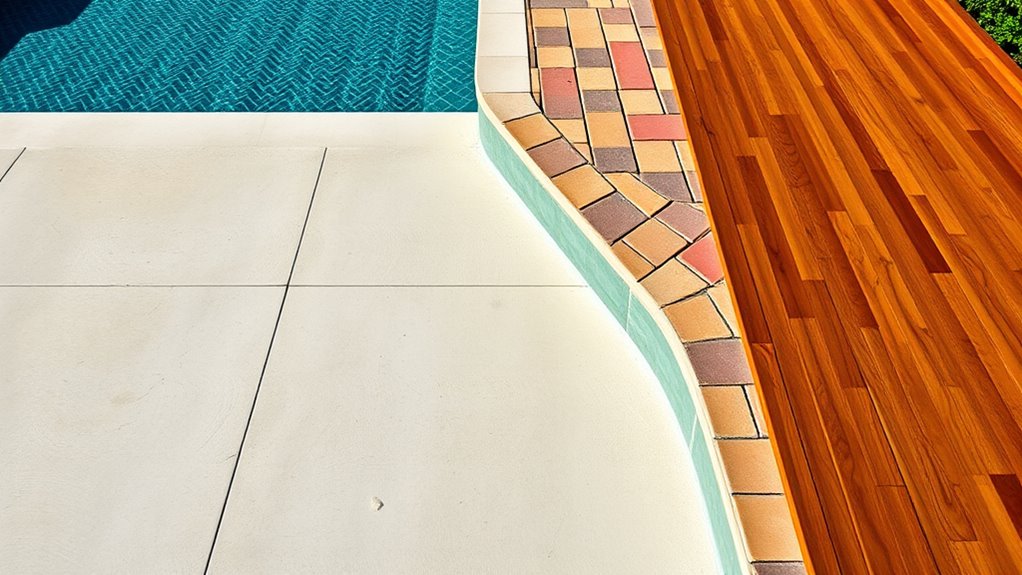
Choosing the right decking material involves balancing appearance with the effort required to keep it looking good. If you want a natural look, wood offers warmth and charm but demands regular sealing and staining to prevent weathering and fading. Concrete provides a sleek, modern appearance that can be customized with stamps or stains, requiring minimal upkeep beyond occasional cleaning. Pavers come in various shapes and colors, creating a stylish, textured surface that’s easy to maintain—just sweep and wash. Consider how each material’s aesthetic fits your style: wood feels cozy, concrete is contemporary, and pavers add visual interest. Keep in mind that some options may age differently, so think about how much effort you’re willing to invest in maintaining their appearance over time. Additionally, choosing durable materials can help ensure your outdoor space remains attractive and functional for years to come.
Cost Considerations and Installation Tips
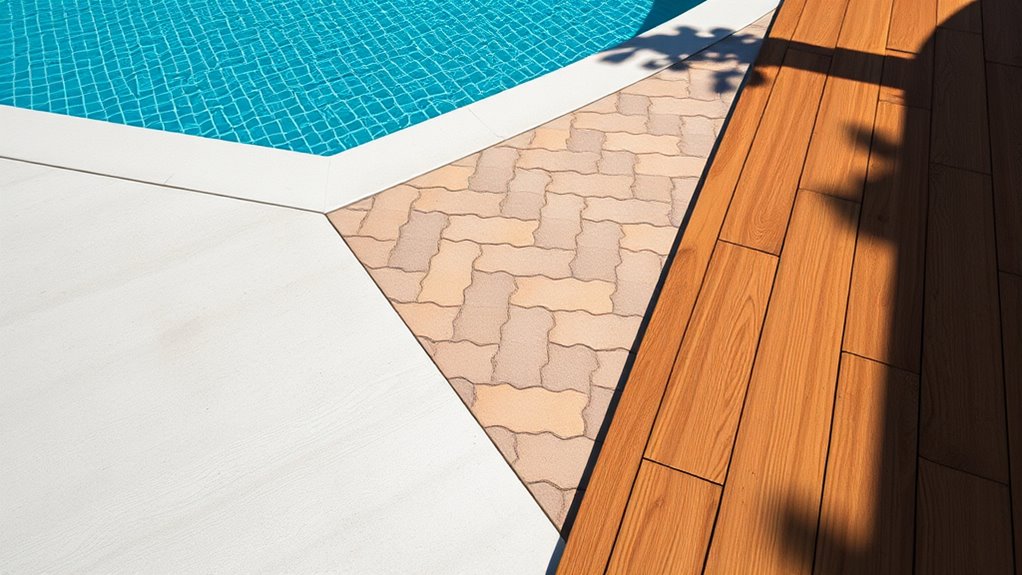
While aesthetics and maintenance are important, understanding the costs involved can help you make a practical decision. Concrete tends to be the most affordable option upfront and is quick to install, but it may require sealing over time to prevent cracks. Pavers are more expensive initially but offer durability and easy repairs; expect to pay more for quality materials and professional installation. Wood decking varies widely in cost depending on the type—pressure-treated pine is budget-friendly, while exotic hardwoods cost more but last longer. To save money, consider DIY installation if you have the skills, and always get multiple quotes from contractors. Proper planning guarantees a smooth process, helps avoid unexpected expenses, and ensures your poolside deck stands up to years of use. Additionally, choosing a high-quality material can significantly impact the longevity and appearance of your deck over time.
Frequently Asked Questions
Which Decking Material Is Most Environmentally Friendly?
You’ll find that wood, especially sustainably harvested or reclaimed wood, is the most environmentally friendly option for pool decking. It’s renewable, biodegradable, and often requires fewer chemicals during production. Pavers made from natural stone or recycled materials are also eco-friendly choices, as they last long and can be recycled. Concrete tends to have a larger carbon footprint due to energy-intensive manufacturing, making it a less green option overall.
How Do Decking Options Affect Pool Safety?
You should prioritize slip resistance and surface temperature to guarantee pool safety. Choose decking options with textured or non-slip surfaces to prevent falls, especially when wet. Avoid materials that become excessively hot under the sun, as they can cause burns. Regular maintenance and cleaning also help keep the surface safe. By selecting the right material and maintaining it properly, you create a safer environment around your pool for everyone.
Can I Install Multiple Decking Materials Together?
Yes, you can install multiple decking materials together, but you need to plan carefully. Make sure the shift between materials is smooth and secure to prevent tripping hazards. Use proper edging or border strips to keep materials in place and guarantee they expand and contract uniformly with temperature changes. Consulting a professional can help you design a safe, attractive, and functional multi-material deck that enhances your pool area.
What Are the Best Decking Choices for High-Traffic Areas?
For high-traffic areas, concrete is your best choice because of its durability and low maintenance. Pavers also work well—they’re sturdy and easy to replace if damaged. Wood can handle traffic if it’s made from tough, treated materials, but it generally needs more upkeep and may wear faster under constant use. Consider your style and maintenance preferences when choosing, but prioritize strength and longevity for busy spaces.
How Do Climate Conditions Influence Material Longevity?
Climate conditions totally dictate how long your decking lasts. If you’re in a scorching sun zone, expect your wood to fade and crack faster than you can say “splinter.” In icy climates, concrete might crack under winter’s brutal freeze. Pavers handle weather extremes better, but heavy rain can cause shifting. So, you’ve got to choose wisely—consider your local climate, because it’s the difference between a deck that endures a lifetime or one that crumbles in a few years.
Conclusion
Choosing the right decking depends on your priorities. Concrete offers durability, pavers add style, and wood provides natural warmth. Did you know that 60% of pool owners prefer low-maintenance options? By considering safety, aesthetics, and budget, you can find the perfect fit for your backyard. Make your decision today, and enjoy a beautiful, safe, and functional space around your pool for years to come.
